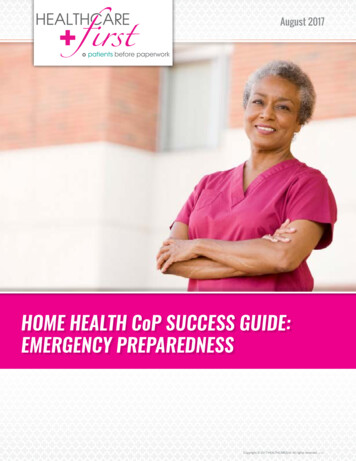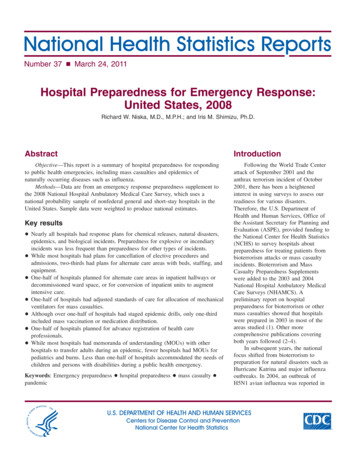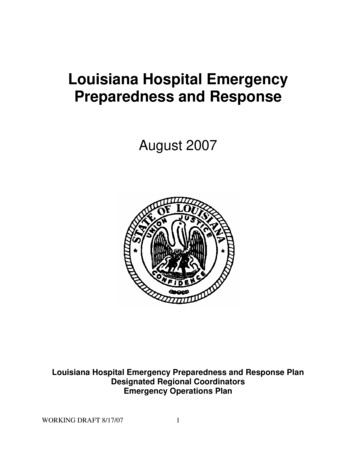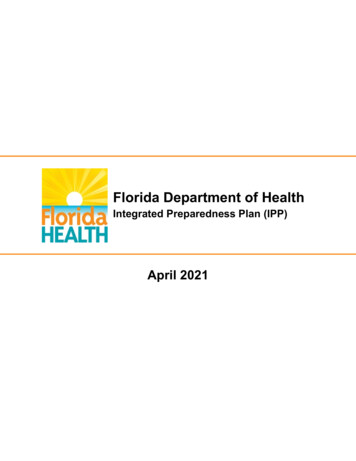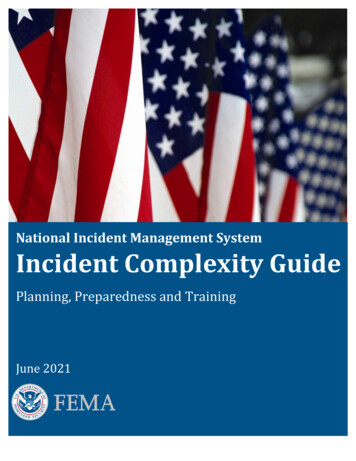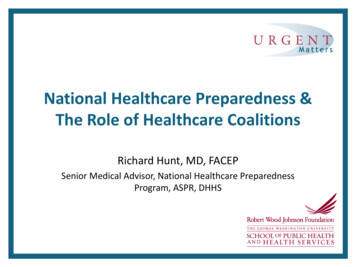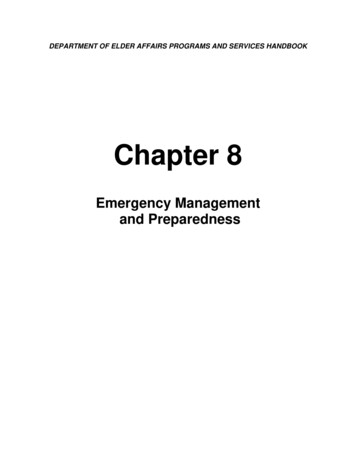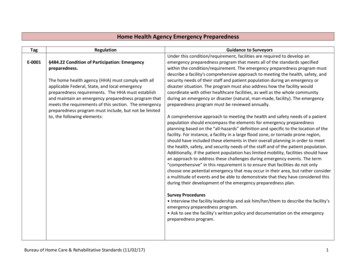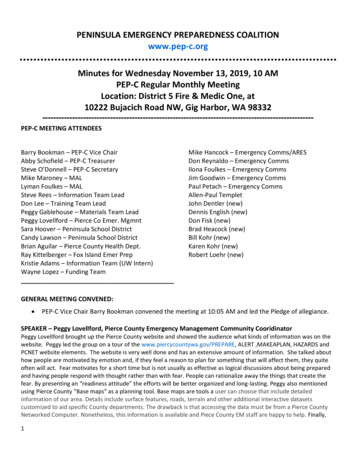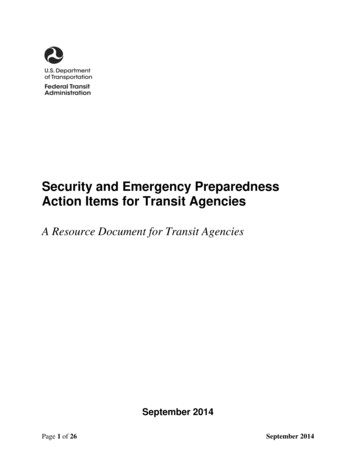
Transcription
Security and Emergency PreparednessAction Items for Transit AgenciesA Resource Document for Transit AgenciesSeptember 2014Page 1 of 26September 2014
NOTICEThis document is disseminated under the sponsorship of the U.S. Department of Transportationin the interest of information exchange. The United States Government assumes no liability forits contents or use thereof.The United States Government does not endorse products or manufacturers. Trade ormanufacturers’ names appear herein solely because they are considered essential to the objectiveof this report.Page 2 of 26September 2014
Form ApprovedREPORT DOCUMENTATION PAGEOMB No. 0704-0188Public reporting burden for implementing this resource is estimated to average one hour per emergency type,including the time for reviewing instructions, gathering and maintaining the data needed, and completing andreviewing the results. Send comments regarding this burden estimate or any other aspect of this document,including suggestions for reducing this burden, to Washington Headquarters Services, Directorate for InformationOperations and Reports, 1215 Jefferson Davis Highway, Suite 1204, Arlington, VA 22202-4302, and to the Officeof Management and Budget, Paperwork Reduction Project (0704-0188), Washington, DC 20503.1. AGENCY USE ONLY (Leave2. REPORT DATE3. REPORT TYPE AND DATESblank)September 2014COVERED4. TITLE AND SUBTITLESecurity and Emergency Preparedness Action Items for Transit Agencies: A ResourceDocument for Transit Agencies6. AUTHOR(S)5. FUNDING NUMBERSVT56A4/MJ555– FTASAFETY AND SECURITYASSESSMENTS (BMI)Kevin L. Chandler, Jodi M. Rizek , and Pamela J. Sutherland8. PERFORMINGORGANIZATION REPORTNUMBER7. PERFORMING ORGANIZATION NAME(S) AND ADDRESS(ES)Battelle, 505 King Avenue, Columbus, OH 432019. SPONSORING/MONITORING AGENCY NAME(S) AND ADDRESS(ES)Office of Transit Safety and OversightFederal Transit Administration, 1200 New Jersey Ave, S.E., Washington, D.C. 2059010. SPONSORING/MONITORINGAGENCY REPORTNUMBER11. SUPPLEMENTARY NOTES12b. DISTRIBUTION CODE12a. DISTRIBUTION/AVAILABILITY STATEMENTNo Restrictions. Available From: National Technical Information Service/NTIS,Springfield, Virginia, 22161. Phone 703.605.6000, Fax 703.605.6900, Email[orders@ntis.fedworld.gov]13. ABSTRACT (Maximum 200 words)Prepared by the Federal Transit Administration’s (FTA) Office of Transit Safety and Oversight, Security and EmergencyPreparedness Action Items for Transit Agencies: A Resource Document for Transit Agencies is part of FTA’s technicalassistance to transit agencies. FTA and TSA collaborated to update and consolidate the FTA Tops 20 Action Items into17 Action Items, which are aligned with TSA’s BASE and the NTAS. These Action Items apply to all transit modesdirectly operated or contracted by transit agencies. Transit Agencies are encouraged to include all of these ActionItems in their security programs scaled appropriately to risk environment and operation size.This document provides an explanation of the current 17 Action Items, including supporting topics that further explainthe content of each Action Item. High-level elements are used to organize and group similar Action Items. Relevantresource documents developed by FTA, DHS, TSA, FEMA, NIST, TRB, USCG, and APTA’s security standards programhave been included for each high-level element. These documents were selected to provide users with additionalinformation and provide industry benchmarks for potential implementation.14. SUBJECT TERMSFederal Transit Administration, Office of Transit Safety and Oversight, Security,Emergency Preparedness15. NUMBER OF PAGES2616. PRICE CODE17. SECURITYCLASSIFICATIONOF REPORT18. SECURITYCLASSIFICATIONOF THIS PAGEUnclassifiedPage 3 of 2619. SECURITYCLASSIFICATIONOF ABSTRACTUnclassified20. LIMITATION OFABSTRACTNoneSeptember 2014
Table of ContentsPageAcronyms and Abbreviations . 5Introduction. 8Management and Accountability. 10Action Item 1. Establish written system security plans (SSPs) and emergencyoperations/response plans . 11Action Item 2. Define roles and responsibilities for security and emergencypreparedness. 11Action Item 3. Ensure that operations and maintenance supervisors, forepersons,and managers are held accountable for security issues under their control . 11Action Item 4. Coordinate security and emergency operations/response planswith local and regional agencies . 12Security and Emergency Response Training . 14Action Item 5. Establish and maintain a security and emergency trainingprogram . 14National Terrorism Advisory System (NTAS) . 15Action Item 6. Establish plans and procedures to respond to the NationalTerrorism Advisory System (NTAS) alert levels . 15Public Awareness . 16Action Item 7. Implement and reinforce a public security and emergencyawareness program. 16Risk Management and Assessment . 17Action Item 8. Establish and use a risk management process . 17Risk Information Collection and Sharing. 18Action Item 9. Establish and use an information sharing process for threat andintelligence information . 18Drills and Exercises. 19Action Item 10. Conduct tabletop and functional drills. 19Cyber-security . 20Action Item 11. Develop a comprehensive cyber-security strategy . 20Facility Security, Access Controls, and Background Investigations . 22Action Item 12. Control access to security critical facilities with identification(ID) badges for all visitors, employees and contractors . 22Action Item 13. Conduct physical security inspections. 22Action Item 14. Conduct background investigations of employees andcontractors. 22Page 4 of 26September 2014
Table of Contents (cont.)PageDocument Control. 25Action Item 15. Control access to documents on security critical systems andfacilities. 25Action Item 16. Process for handling and access to sensitive security information(SSI) . 25Security Program Audits. 26Action Item 17. Establish and conduct security program audits . 26List of TablesTable 1. Resource Document Links . 9Page 5 of 26September 2014
Acronyms and AbbreviationsAPTA-American Public Transportation AssociationBASE-Baseline Assessment and Security EnhancementCEOCCTVCOOPCPGCPTEDCFR-chief executive officerclosed circuit televisioncontinuity of operations plancomprehensive preparedness guidecrime prevention through environmental designCode of Federal RegulationsDCSDHSDOT-distributed control systemU.S. Department of Homeland SecurityU.S. Department of TransportationEOPEOPERP-emergency operations planemergency operations procedureemergency response planFBIFEMAFTA-Federal Bureau of InvestigationFederal Emergency Management AgencyFederal Transit AdministrationHSASHSEEPHSINHVAC-Homeland Security Advisory SystemHomeland Security Exercise and Evaluation ProgramHomeland Security Information Networkheating, ventilation, and air conditioningICSICSIDIDPSIEDIT-incident command systemindustrial control systemsidentificationintrusion detection and prevention systemimprovised explosive deviceinformation technologyJTTF-Joint Terrorism Task ForceLAN-local area networkMAAMOAMOU-mutual aid agreementmemorandum of agreementmemorandum of understandingPage 6 of 26September 2014
Acronyms and Abbreviations ational Cooperative Highway Research ProgramNational Disaster Recovery FrameworkNational Incident Management SystemNational Infrastructure Protection PlanNational Institute of Science and TechnologyNational Response FrameworkNational Terrorism Advisory SystemNational Transit DatabaseNavigation and Vessel Inspection CircularNew York City Metropolitan Transportation AuthorityPLCPT-ISAC-programmable logic controllerPublic Transportation – Information Sharing and Analysis CenterSCADASEPPSOPSSISSPSTSI-supervisory control and data acquisitionsecurity and emergency preparedness planstandard operations proceduresensitive security informationsystem security planSurface Transportation Security InspectorTCRPTEWGTSATSOCTRBTVC-Transit Cooperative Research ProgramTerrorism Early Warning GroupTransportation Security AdministrationTransportation Security Operations CenterTransportation Research Boardthreat, vulnerability, and consequenceUS-CERTUSCG-United States Computer Emergency Readiness TeamU.S. Coast GuardWANWMD-wide area networkweapons of mass destructionsPage 7 of 26September 2014
IntroductionFollowing the events of September 11, 2001, the Federal TransitAdministration (FTA) developed security and emergency preparednessresources and provided technical assistance to transit agencies acrossthe U.S. One of these activities was the development of the “Top 20Security and Emergency Preparedness Action Items for TransitAgencies,” which was published by FTA in 2003. In 2006 FTA andTSA collaborated to update and consolidate the FTA Top 20 ActionItems into the (17) “TSA/FTA Security and Emergency PreparednessAction Items for Transit Agencies.” The organization of these 17Action Items and experience from the FTA and TSA technicalassistance efforts were used by TSA to develop their voluntary securityand emergency preparedness assessment tool, Baseline Assessment and Security Enhancement(BASE). TSA’s Surface Transportation Security Inspector (STSI) activity uses the BASEchecklist to work with transit agencies on a voluntary basis to complete programmaticassessments of the security and emergency preparedness program.In 2012, FTA and TSA revised the Action Items to ensure alignment with changes being made toTSA’s BASE. These recent changes are reflected in the Action Items presented in thisdocument. The main changes to the Action Items were to add cyber-security as a topic, replacethe now defunct color-coded Homeland Security Advisory System (HSAS) with the NationalTerrorism Advisory System (NTAS) and to revise and highlight the priorities of riskmanagement and risk information gathering and analysis. All changes were made in consultationthrough the TSA’s Mass Transit Sector Coordinating Council chaired by the American PublicTransportation Association (APTA).These security and emergency preparedness Action Items are intended to reflect the high-levelpriority topics included in a transit agency’s security and emergency preparedness program1.These Action Items apply to all transit modes directly operated or contracted by transit agencies(e.g., bus, bus rapid transit, light rail/streetcar, heavy rail, commuter rail, and paratransit).Transit agencies are encouraged to include all of these Action Items in their security programsscaled appropriately to risk environment and operation size.This document provides an explanation of the current 17 Action Items, including supportingtopics that further explain the content of each Action Item. High-level elements are used toorganize and group similar Action Items. Relevant resource documents developed by FTA,DHS, TSA, FEMA, NIST, TRB, USCG and APTA’s security standards program have beenincluded for each high-level element. These documents were selected to provide users withadditional information and provide industry benchmarks for potential implementation. Table 1provides links to the websites where these resource documents are located.1Note that emergency preparedness at a transit agency is shared between the safety and security programs. In thisdocument, emergency preparedness is presented from only the security program perspective.Page 8 of 26September 2014
Table 1. Resource Document p?id vic/Security.aspFEMAFTAPage 9 of 26September 2014
Management and AccountabilityThere are four Action Items under this element that address development, approval, and rollingout the security program and emergency operations/response plans, including regionalcoordination for these activities. The system security plan (SSP) or security and emergencypreparedness plan (SEPP) provide an up-to-date description of the security program at a transitagency and used as the baseline to compare/audit and test the security-related activities. Capitalprojects also are also a part of the security program and emergency operations/response planning.It is critical that the processes and activities described in the program documentation andemergency operations/response plans are well understood, approved, and endorsed byexecutive/senior level management at the transit agency. In addition, it is just as important thatthe roles and responsibilities for executing the security program and emergencyoperations/response plans are rolled out to and understood by staff. Performance metrics shouldbe established so that managers and supervisors are held accountable and that all tasks have beenaddressed.Transit agencies often have many emergency operations/response plans. These plans aredeveloped in a similar fashion as the program documentation and require an update process tokeep the plans current and accurate. Some plans describe operations for a specific type of event,and others describe overall operations or response. Types of emergency operations, contingency,or response plans are: Emergency operations plan (EOP)/emergency response plan (ERP) – includes specificplans such as hazardous material, bomb threat, suspicious package/improvised explosivedevice (IED), active shooter, weapons of mass destruction (WMD), and heightenedthreat/alert conditionsCyber incident responseBusiness continuity planning – includes continuity of operations plan (COOP), loss ofcommunications, loss of powerPandemic planningWeather/natural disaster plans – hurricane, winter (snow/ice), summer/heat, tornado,flood, earthquake, fire, and drought; this includes special staging of vehiclesSpecial events plans – parades, festivals, and sporting events; this includes special stagingof vehiclesEvacuation plans – these could be notice or no-notice, includes facilities and stations, andspecial needs passengersAnother high-priority activity is coordination with local, regional, State, and Federal agencieswith security and emergency preparedness/response responsibilities that overlap with the transitagency. The transit agency is expected to reach-out and participate in local, regional, State, andFederal planning, training/awareness, and drills and exercises. This participation needs to beused to advise the safety and security programs with those local, regional, State, and Federalexpectations. The transit agency will also want to share important information with local andregional responders to protect the responders and the transit agency assets.Page 10 of 26September 2014
Action Item 1. Establish written system security plans (SSPs) and emergencyoperations/response plansa. Ensure that security and emergency operations/response plans aresigned/approved by senior level managementb. Review plans and documentation at least annually and update as circumstanceswarrantc. Ensure the security and emergency operations/response plans integrate visibility,randomness, and unpredictability into security deployment activities to avoidexploitable patterns and to enhance deterrent effectd. Establish and maintain standard security and emergency operations procedures(SOPs/EOPs) for each mode operated, including procedures for operations controlcenterse. Establish plans and procedures that address specific threats from (i) improvisedexplosive devices (IED), (ii) weapons of mass destruction (WMD), and (iii) otherhigh consequence risks identified in transit risk assessmentsf. Apply security design and crime prevention through environmental design(CPTED) criteria for major capital construction projects, system modifications,and procurementsg. Ensure the security and emergency operations/response plans address continuityof operationsh. Ensure security and emergency operations/response plans address businessrecoveryAction Item 2. Define roles and responsibilities for security and emergency preparednessa. Assign security and emergency preparedness activities to a senior level managerb. Maintain a current record of the name and title of the Primary and AlternateSecurity Coordinator (includes Security Directors and Transit Police Chiefs)c. Ensure that Security Coordinators report to senior level managementd. Maintain accurate contact information for Security Coordinators and ensure theyare accessible by telephonic and electronic communications means at all timese. Ensure that management defines and delegates security duties to front lineemployeesf. Ensure that security and emergency operations/response plans are distributed toappropriate departmental personnel in the organizationg. Hold regular senior staff and middle management security coordination meetingsh. Hold informational briefings with appropriate personnel whenever security plansand procedures are substantially updatedi. Establish lines of delegated authority/succession of security responsibilities andinform personnelAction Item 3. Ensure that operations and maintenance supervisors, forepersons, andmanagers are held accountable for security issues under their controla. Hold regular supervisor and foreperson security review and coordination briefingsb. Develop and maintain an internal security incident reporting systemc. Ensure that a Security Review Committee (or other designated group) regularlyreviews security incident reports, trends, and security program audit findings, andPage 11 of 26September 2014
makes recommendations to senior level management for changes to plans andproceduresAction Item 4. Coordinate security and emergency operations/response plans with local andregional agenciesa. Coordinate with Federal and State governmental entities associated with publictransportation security (e.g., Surface Transportation Security Inspectors (STSI)Area Office, State Office of Homeland Security, FTA Regional Office, FederalBureau of Investigation (FBI) Joint Terrorism Task Force (JTTF), Office of StateSafety Oversight, etc.) in the regional area of the transit agencyb. Ensure consistency with the National Incident Management System (NIMS) andthe National Response Framework (NRF)c. Establish memorandums of agreement (MOA) or mutual aid agreements (MAA)with local government, fire, police and other entities with shared infrastructure(e.g., other transit agencies or rail systems)d. Maintain communications interoperability with first responders with securityresponsibilities in the transit system’s regional areaRelated Resource DocumentsSecurity Program Documentation The Public Transportation System Security and Emergency Preparedness PlanningGuide, FTA, 2003 Bus Safety and Security Program, Safety, Security, and Emergency PreparednessExcellence – A Roadmap, FTA, 2012 Transit Security Design Considerations, FTA, 2004 Recommended Practice for the Development and Implementation of a Security andEmergency Preparedness Plan (SEPP), APTA-SS-SRM-RP-001-09, Rev. 1, 2012 Security Planning for Public Transit, APTA-SS-SIS-RP-011-13, 2013 Security Considerations for Public Transit, APTA-SS-SIS-S-010-13, 2013 Random Counterterrorism Measures on Transit Systems, APTA-SS-SRM-RP-00611, 2011Emergency Operations/Response and Regional Coordination Response and Recovery for Declared Emergencies and Disasters, A ResourceDocument for Transit Agencies, FTA, 2013 Guidelines for Managing Suspected Chemical and Biological Agent Incidents in RailTunnel Systems, FTA, 2004 (Law Enforcement Sensitive) National Incident Management System, DHS, 2008 National Response Framework (NRF), DHS, 2013 National Disaster Recovery Framework (NDRF), DHS, 2011 Developing and Maintaining Emergency Operations Plans, ComprehensivePreparedness Guide (CPG) 101, Version 2.0, FEMA, 2010 TCRP Report 160, Paratransit Emergency Preparedness and Operations Handbook,TRB/TCRP, 2013 The Role of Transit in Emergency Evacuation, TRB SF-294, 2008Page 12 of 26September 2014
TCRP Report 86, Volume 8, Continuity of Operations (COOP) Planning Guidelinesfor Transportation Agencies, TRB/TCRP, 2005Standard for a Continuity of Operations Plan, APTA-SS-SEM-S-001-08, 2008Standard for Security & Emergency Management Aspects of Special Events Service,APTA-SS-SEM-S-003-08, 2008Recommended Practice for Participating in Mutual Aid, APTA-SS-SEM-RP-011-09,2009Recommended Practice for First Responder Familiarization of Transit Systems,APTA-SS-SEM-RP-002-08, 2008Emergency Communication Strategies for Transit Agencies, APTA-SS-SEM-RP-00909, 2009Developing a Contagious Virus Response Plan, APTA-SS-SEM-S-005-09, 2009Shelter of Transit Vehicles and Nonrevenue Equipment During Emergencies, APTASS-SEM-S-006-09, 2009Recommended Practice Creating an Alternate or Backup OCC, APTA-SS-SEM-RP007-09, 2009Page 13 of 26September 2014
Security and Emergency Response TrainingSecurity and emergency response training is focused on assurance of job-specific certificationand proficiency. Establishing a strong security and emergency response program is vital toensuring that an agency can respond quickly during an unplanned or planned event. Employeesand contractors who may provide a primary response to an event because of their job functionshould receive advanced and refresher training on a regular basis. The training should reinforceroles and responsibilities in an event, as well as measure proficiency in carrying out assignedduties. Proficiency expectations for employees and contractors should determine content of thetraining classes.Action Item 5. Establish and maintain a security and emergency training programa. Provide ongoing basic training to all employees in (i) securityorientation/awareness and (ii) emergency responseb. Provide ongoing advanced (i) security and (ii) emergency response training by jobfunction, including actions at incremental threat levels, to field supervisors,controllers/dispatchers, fare inspectors, law enforcement personnel, operators,maintenance personnel (field and vehicle)c. Provide ongoing advanced security training programs for transit managers,including but not limited to chief executive officers (CEOs), General Managers,Operations Managers, and Security Coordinators (includes Security Directors andTransit Police Chiefs)d. Regularly update security awareness, emergency response, and counter-terrorismtraining materials to address (i) improvised explosive devices (IEDs), (ii)weapons of mass destruction (WMD) and (iii) other high consequence risksidentified through the transit agency’s system risk assessmentse. Ensure that security training programs reinforce security roles, responsibilities,and duties of employees, and ensure proficiency in their performancef. Ensure security training programs emphasize integration of visible deterrence,randomness, and unpredictability into security deployment activities to avoidexploitable patterns and heighten deterrent effectg. Establish a system that records personnel training in (i) security and (ii)emergency response: initial training, recurrent training (periodic, refresher),establish and maintain a security notification process to inform personnel ofsignificant updates to security and emergency operations/response plans andproceduresRelated Resource Documents Immediate Actions for Transit Employees: Protecting Against Life-ThreateningEmergencies, A Resource Document for Transit Agencies, FTA, 2011 Security Awareness Training for Transit Employees, APTA-SS-SRM-RP-005-12,2012Page 14 of 26September 2014
National Terrorism Advisory System (NTAS)In support of terrorism prevention and protection, the National TerrorismAdvisory System (NTAS)2 was implemented in 2011 and the HomelandSecurity Advisory System (HSAS) color codes were discontinued. TheNTAS is a two-level terrorism threat advisory scale, “elevated” and“imminent.” An elevated threat alert “warns of a credible terrorist threatagainst the United States.” An imminent threat alert “warns of a credible,specific, and impending terrorist threat against the United States.” Inaddition, the TSA works with public transportation agencies and providescommunications of potential security protective measures and strategiesthat can be used during higher-threat levels, such as NTAS threatadvisories.Action Item 6. Establish plans and procedures to respond to the National TerrorismAdvisory System (NTAS) alert levelsa. Security and emergency operations/response plans and procedures should identifyincremental actions to be implemented at NTAS alert levelsb. Exercises should test implementation of the preventive measures for NTAS alertlevels, including random application of security measuresRelated Resource Documents National Terrorism Advisory System Public Guide, DHS, 2011 TSA Mass Transit, Bus and Passenger Rail Security Awareness Message, ProtectiveMeasures December 6, 2011, TSA Random Counterterrorism Measures on Transit Systems, APTA-SS-SRM-RP-00611, 20112The NTAS and related documents are available from DHS at em.Page 15 of 26September 2014
Public AwarenessThis element is focused on establishing activities for public communications and awareness ofsecurity and emergency preparedness. Communications include public address systems,electronic message boards, posters, channel cards on vehicles, fliers, internet website, email,phone systems, etc. The frequency of messaging and content of the communication undervarious hazard and threat situations needs to be considered. All types of emergency situationsneed to be considered such as natural and man-made situations. Special event communicationsshould also be included in these activities.Part of this activity includes establishing the ability for the public to communicate problems(hazards and threats) within the transit system. This activity also includes communicating theagency’s interest in having this hazard and threat information and how the agency will respondto anything reported. Based on experience through day-to-day operations, real emergencies, anddrills and exercises, the transit agency should make improvements and changes to thesecommunications activities and products on a regular basis.Action Item 7. Implement and reinforce a public security and emergency awarenessprograma. Develop and implement a public security and emergency awareness programb. Prominently display security awareness and emergency preparedness informationmaterials throughout the system (e.g., channel cards, posters, fliers)c. Incorporate general security awareness and emergency preparedness into publicannouncement messages (e.g., security messages and evacuation procedures) instations (e.g., electronic message boards, voice) and on board vehiclesd. Post security awareness and emergency preparedness information on the transitagency websitee. Ensure security awareness materials and announcements emphasize theimportance of vigilance and provide clear direction to the public on reporting ofsuspicious activitiesf. Vary the content and appearance of messages to retain public interestg.
and emergency preparedness assessment tool, Baseline Assessment and Security Enhancement (BASE). TSA's Surface Transportation Security Inspector (STSI) activity uses the BASE checklist to work with transit agencies on a voluntary basis to complete programmatic assessments of the security and emergency preparedness program.
